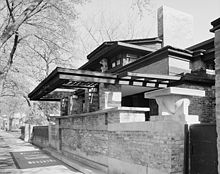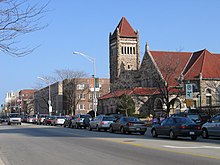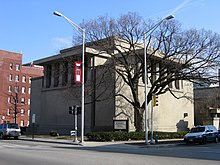Oak Park, Illinois: Difference between revisions
Undid revision 246711467 by Footballhead56 (talk) |
|||
| Line 232: | Line 232: | ||
*[[Ray Kroc]] founder of [[Mcdonald's]] |
*[[Ray Kroc]] founder of [[Mcdonald's]] |
||
*[[Johnny Lattner]], Notre Dame Football Player, 1953 Heisman Trophy Winner |
|||
*[[Thomas Lennon]] actor |
*[[Thomas Lennon]] actor |
||
*[[Ludacris]], rapper |
*[[Ludacris]], rapper |
||
Revision as of 23:04, 22 October 2008

Oak Park, Illinois is a suburb bordering the west side of the City of Chicago in Cook County, Illinois, United States. Oak Park has easy access to downtown Chicago (the Chicago Loop) thanks to public transportation such as the Chicago 'L' Blue and Green lines, CTA buses, and Metra commuter rail. As of the 2000 census, the area had a total population of 52,524. A census estimate for 2003 showed that the population had dipped to 50,824.
History
This article contains weasel words: vague phrasing that often accompanies biased or unverifiable information. |
In 1837, Joseph Kettlestrings purchased 172 acres[1] of land just west of Chicago. By 1850, the Galena and Chicago Union Railroad was constructed as far as Elgin, Illinois, and passed through Oak Park[2]. The population of Oak Park boomed during the 1870s, with Chicago residents resettling in the suburb following the Great Chicago Fire of 1871. The Village of Oak Park was formally established in 1902, following a referendum.
Oak Park has a history of alcohol prohibition. From the time of its incorporation, no alcohol was allowed to be sold within its village limits. This law was relaxed in 1973, when restaurants and hotels were allowed to serve alcohol. The law was further loosened in 2002, when select grocery stores were given permission to sell packaged liquor.
Oak Park's expansive homes, parks and an excellent school system have continued to position the village very high among the suburbs of Chicago. Recently, Oak Park demographics have shifted from long-term, more conservative residents, to younger, urban, more liberal residents. The division between old and new residents was demonstrated by a formal survey of residents taken in 2004,[3] which found that more than half of current residents had lived in Oak Park for less than ten years, and one-third had lived in the village fewer than five.
The village has attempted to balance historic preservation and economic development. For example, a pedestrian mall on Marion Street in the center of the village was opened to traffic, using brick pavers similar to the original early 20th century street and bluestone sidewalks, intended to highlight the historic character of the area. Even the lighting fixtures were chosen to evoke the look of streetlights that lined the street in the 1920s. The effort to remove the mall from downtown Oak park has won acclaim throughout the region from urban planners and preservationists alike. [4]

Oak Park also is a popular tourist destination in the Chicago area, as many come to view the many Frank Lloyd Wright buildings found throughout the village. The largest collection of Wright-designed residential properties in the world is in Oak Park. Other famous attractions include Ernest Hemingway's birthplace home and boyhood home, the Ernest Hemingway Museum, the three Oak Park homes of Tarzan creator Edgar Rice Burroughs.
Oak Park has become famous in the Chicago area and throughout Illinois for its rather impressive Oak Park River Forest High School[5], which is also the public education school for the bordering village of River Forest. The school is known for its large number of successful alumni, honored teachers, and advanced educational programs.
Geography
Oak Park is located immediately west of Chicago. The boundary between the two municipalities is Austin Boulevard on the east side of Oak Park and North Avenue on the village's north side. Oak Park also borders Cicero along its southern border, Roosevelt Road, from Austin to Lombard; and Berwyn from Lombard to Harlem. Harlem also serves as its western border, where between Roosevelt and South Blvd, it borders Forest Park and between North Blvd and North Ave to the west it borders River Forest.
The entire village of Oak Park lies on the shore of ancient Lake Chicago, which covered most of the city of Chicago during the last Ice Age and is today called Lake Michigan. Ridgeland Avenue in eastern Oak Park marks the shoreline of the lake, and was once an actual ridge. One of North America's four continental divides runs through Oak Park. This divide, a slight rise running north-south through the village, separates the St. Lawrence River watershed from the Mississippi River watershed, and is marked by a plaque on Lake Street at Forest Avenue.
According to the United States Census Bureau, the village has a total area of 4.7 square miles (12.2 km²). None of it is covered by water.
Transportation

Oak Park is accessible from Chicago by both Chicago Transit Authority Green and Blue line trains as well as Metra UP-West Line trains at Oak Park station. Service within Oak Park and to other suburbs is also provided by the suburban bus system Pace. It is also one of over 20 neighborhoods served by I-GO Cars.
The Eisenhower Expressway--formerly the Congress Expressway--is the primary highway between Chicago and Oak Park. Oak Park has its own street numbering system that is similar to, but distinct from, Chicago's system.

Oak Park has a rich tradition of bicycling. Augusta Boulevard through the village is part of the Grand Illinois Trail; the trailhead of the Illinois Prairie Path is less than a mile from Oak Park. It is considered one of the most progressive bicycle-friendly communities in the Chicago area and has a number of active cycle clubs and groups. Proximity to trails and the historic tree-lined streets of the community attract cyclists from throughout the region, many of whom arrive by the Chicago area's extensive public transportation system. Oak Park also has a small pedicab business, owned and operated by a local who provides guided tours and a taxi service with his bicycle pedicabs or rickshaws. There is also a free shuttle service which transports riders to most of the tourist attractions in the village [6].
Neighborhoods
Though located within a small geographical area, the village of Oak Park contains several distinct neighborhoods. Some regions of northern Oak Park, commonly defined as being north of Lake Street, are traditionally the richest region of the community, and contain such areas as the historical Frank Lloyd Wright District. Various mansions are found in northern Oak Park, especially along tree-lined Chicago Avenue and north Oak Park Avenue. The area between Lake Street and Madison Street, or the mid section of Oak Park, is home to various architectural styles and incomes, with 19th-century Victorian mansions located beside smaller homes of the post-World War 2 era. Southern Oak Park, south of Madison Street, contains homes and families of a more average income, with most of the homes less expensive than in the north. This is offset by the homes in the Seward Gunderson Historic District, which contains some of the first homes in the area from the 1900s. As a whole Oak Park can be characterized as both middle-upper and upper class.
Though there are several business districts within Oak Park, such as the Harrison Street Arts District along the I-290 expressway and Chicago Avenue at Harlem, downtown Oak Park is the main business district, bordered at the west by Harlem Avenue, at the east with Oak Park Avenue/Euclid Avenue, south by South Boulevard/Pleasant Street, and north by Ontario Street. However, there is a growing vacancy rate within downtown Oak Park. Some of the independent, "mom-and-pop" stores have moved out, making room for brand-name chain stores such as Cold Stone Creamery and Starbucks. There has been a great deal of heated discussion and debate within the village as to the cause of these vacancies and the solution to ending this problem. In the past several months a number of those vacant store fronts have been occupied.
Demographics
As of the censusTemplate:GR of 2000, there were 52,524 people, 23,079 households, and 12,970 families residing in the village. The population density was 11,173.4 people per square mile (4,314.8/km²). There were 23,723 housing units at an average density of 5,046.6/sq mi (1,948.8/km²). The racial makeup of the village was 68.78% White, 22.44% African American, 0.15% Native American, 4.15% Asian, 0.03% Pacific Islander, 1.63% from other races, and 2.82% from two or more races. Hispanic or Latino of any race were 4.52% of the population. 14.5% were of Irish, 11.3% German, 6.8% Italian and 5.5% English ancestry according to Census 2000. 88.1% spoke English and 4.2% Spanish as their first language.
There were 23,079 households, out of which 29.5% had children under the age of 18 living with them, 42.1% were married couples living together, 11.6% had a female householder with no husband present, and 43.8% were non-families. 37.0% of all households were made up of individuals and 8.6% had someone living alone who was 65 years of age or older. The average household size was 2.26 and the average family size was 3.06.
In the village the population was spread out with 24.2% under the age of 18, 6.7% from 18 to 24, 35.2% from 25 to 44, 24.4% from 45 to 64, and 9.5% who were 65 years of age or older. The median age was 36 years. For every 100 females there were 86.9 males. For every 100 females age 18 and over, there were 82.2 males.
The median income for a household in the village was $59,183, and the median income for a family was $81,703. Males had a median income of $51,807 versus $40,847 for females. The per capita income for the village was $36,340. About 3.6% of families and 5.6% of the population were below the poverty line, including 5.8% of those under age 18 and 7.9% of those age 65 or over.
Oak Park has a long history of encouraging and maintaining racial and ethnic diversity, much of which was started in conjunction with the 1966 Chicago Open Housing Movement. The village operates a Diversity Assurance Program within its housing programs department to ensure a stable, diverse, and integrated population. Years ago, Oak Park eliminated the use of "For Sale" signs in front of houses, widely considered one of the keys of success to maintaining the high diversity. However, this law is unconstitutional. It was overturned by Linmark Associations, Inc. v. Township of Willingboro, 431 U.S. 85, Supreme Court of the United States, 1977. Justice Thurgood Marshall delivered the opinion of the Court.
Education

Public primary (Lincoln, Mann, Longfellow, Beye, Holmes, Whittier, Irving, and Hatch) and middle schools (Percy Julian, formerly Nathaniel Hawthorne, and Gwendolyn Brooks, formerly Ralph Waldo Emerson) are operated by the Oak Park Elementary School District. These schools are part of educational District 97, which just approved its strategic plan for the next six years.[7] Oak Park is the home of two high schools: Oak Park and River Forest High School (also known as OPRF), the sole school in educational District 200, and Fenwick High School. OPRF is a public school which is jointly run by Oak Park and neighboring village River Forest, and Fenwick High School is a Catholic college preparatory school run by the Dominicans. Both high schools, seen by some as cross-town rivals, have a long history of high academic standards. OPRF, for example, bestows an award upon select, distinguished alumni (the Tradition of Excellence Award), including Ernest Hemingway, Ray Kroc, Dan Castellaneta, football Hall-of-Famer George Trafton, actress Mary Elizabeth Mastrantonio, ballerina Helene Alexopoulos and astronomer Chad Trujillo. OPRF is also one of the few high schools in the country, and one of seven in Illinois, with the ability to induct students into the Cum Laude Society. Other notable OPRF alumni include management consultant and author Allan Cox. Fenwick's notable alumni include Heisman winner Johnny Lattner, Pulitzer winner Philip Caputo, former Sears CEO Edward Brennan, Illinois Lt. Governor Pat Quinn, Sun-Times general manager John Barron, Proctor & Gamble CEO A. G. Lafley and players in the NFL, NHL and NBA.
Architecture of Oak Park


Frank Lloyd Wright spent the first 20 years of his 70-year career in Oak Park, building numerous homes in the community, including his own. He lived and worked in the area between 1889 and 1909. One can find Wright's earliest work here, like the Winslow House in neighboring River Forest, Illinois. There are also examples of the first prairie-style houses in Oak Park. He also designed Unity Temple, a Unitarian church, which was built between 1905 and 1908. There were several well-known architects and artists that worked in Wright's Oak Park Studio, including Richard Bock, William Eugene Drummond, Marion Mahony Griffin, and Walter Burley Griffin. Many buildings in Oak Park were built by other Prairie School architects such as George W. Maher, Robert C. Spencer, John Van Bergen, and E.E. Roberts. Additionally, there are various architectural styles of the late 19th and early 20th centuries located throughout the town, including the Seward Gunderson Historic District.
Points of interest

- Frank Lloyd Wright Home and Studio
- Oak Park Conservatory
- Unity Temple
- Fenwick High School
- Marshall Field and Company Store
- Ernest Hemingway Museum
Notable people
- Joseph Aiuppa, mafiosi
- Lee Archambault, astronaut
- Richard Bach writer
- William Eugene Blackstone 19th century evangelical Christian and Zionist.
- Wallace Broecker, geochemist
- Edgar Rice Burroughs, Tarzan creator
- Dan Castellaneta actor and voice of Homer Simpson.
- Joe Corvo, NHL defenseman
- Allan Cox, management consultant and author
- Leslie Erganian. and artist
- Matthew and Eleanor Friedberger of the indie rock band The Fiery Furnaces
- Johnny Galecki, actor
- Mason Gamble, actor
- Sam Giancana, mafiosi
- Kathy Griffin comedienne
- Gene Ha, comic book artist
- George Halas, National Football League founder
- Ernest Hemingway writer
- Doris Humphrey internationally acclaimed choreographer and dancer
- Steve James, documentary filmmaker
- Percy Lavon Julian, chemist
- Joseph Kerwin, astronaut
- E. E. Knight, writer
- John Frush Knox, memoirist
- Ray Kroc founder of Mcdonald's
- Johnny Lattner, Notre Dame Football Player, 1953 Heisman Trophy Winner
- Thomas Lennon actor
- Ludacris, rapper
- Charles MacArthur, journalist and filmwriter
- John Mahoney, former Frasier star
- Mary Elizabeth Mastrantonio actress
- Edith Nash writer
- Bob Newhart actor
- Agnes Newton Keithwriter
- Caroline Myss, spiritual author.
- Carl Rogers psychologist (his birthplace)
- Peter Sagal, host of NPR's "Wait Wait...Don't Tell Me!"
- George Schaefer TV director
- Bruce Schneier, cryptographer
- Richard Sears, businessman
- Mike Shanahan head coach of the Denver Broncos
- Carol Shields, , author
- Charles Simic, Poet Laureate of the United States
- Tony Spilotro, mafiosi
- John Sturges, filmmaker
- Judy Tenuta comedienne
- Dorothy Thompson journalist
- Chad Trujillo, astronomer
- Robert Wahl, two-time All-American and former president of Valmont Industries
- Chris Ware Cartoonist
- Ben Weasel, rocker
- Betty White actor
- Frank Lloyd Wright architect. (His home and studio, and many buildings he designed can be found throughout Oak Park)
- Marjorie Vincent, Miss America 1991
Culture and the Arts
Oak Park is known for a thriving arts community. The Arts District on Harrison, bounded by Austin Avenue to the east and Ridgeland Avenue to the west, is currently experiencing a revival with many boutique galleries, shops and restaurants providing unique shopping and nightlife. Oak Park is home to several professional dance and theatre companies, and there is a renewed effort to create a cultural arts center. Both middle schools (Percy Julian and Gwendolyn Brooks) have theater programs called CAST and BRAVO, respectively. Oak Park is also home to WPNA, broadcasting from the former Oak Park Arms Hotel at 1490 on the AM dial since 1951. Run by the Polish National Alliance, the station's programming serves the diverse linguistic and cultural communities in the Chicago metropolitan area.
References
- ^ Oak Park village history
- ^ Galena & Chicago Union Railroad - Chicago Public Library, timeline
- ^ Microsoft Word - Oak Park 2004 Final-4.doc
- ^ Lake Street - Great Public Spaces | Project for Public Spaces (PPS)
- ^ ABC7 Chicago, School Days: Oak Park River Forest High School]
- ^ Oak Park Shuttle Information
- ^ Oak Park Elementary School Distract 97, Strategic Planning, August 07 Plan
Date from the Oak Park and River Forest Historical Society and the Oak Park Center of Creativity.
External links
- Village of Oak Park website
- Park District of Oak Park
- [http://www.visitoakpark.com/ Oak Park Area Convention and Visitors
- [http://www.liveinoakpark.com/ Oak Park Regional Housing Center
Bureau website]
- Historical Society of Oak Park website
- Ernest Hemingway Birthplace and Museum website
- Frank Lloyd Wright Home & Studio, Frank Lloyd Wright Preservation Trust website
- Frank Lloyd Wright's Unity Temple website
- Pleasant Home website
- Wednesday Journal of Oak Park and River Forest
- Oak Park Public Library
- Oak Park Arts District
- Village Players Theatre
- Momenta
- Open Door Repertory Company
- Oak Park Festival Theatre
- 49 Lake Teen Center


